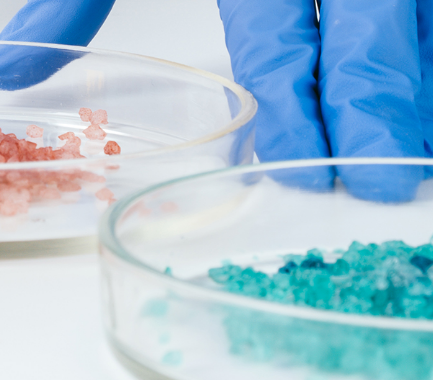Your contact
PENPET-Team - Hamburg

Tim Meister
Sales
Tel. +49 (0) 40 - 675 7 99 40
sales@penpet.de
Get in touch with us.
Barium Hydroxide
Barium hydroxide is a salt-like compound from the group of alkaline earth metal hydroxides, which is an important laboratory chemical, and is used in the chemical industry as an intermediate for the production of other barium compounds and for various technical applications. To produce the substance, the compounds barium sulfide and barium oxide obtained from heavy spar are mixed with water, with the resulting barium hydroxide precipitating as a crystalline solid.
Barium hydroxide serves, among other things, as a precursor for the use of other barium compounds. In ceramic and glass production, the substance is also used as a substitute for barium carbonate. Because of its ability to form different crystalline structures at different temperatures, barium hydroxide can be used to store thermal energy. In analytical chemistry, the substance is also used as a detection agent for carbonates and carbon dioxide, while in industrial applications it is used to remove sulfates from materials and products.
At PENPET, you can get barium hydroxide (octahydrate) of the highest quality, from a reliable partner who will also meet your requirements in the long term. We look forward to receiving your inquiry for an individual offer. Prompt delivery of the crystalline solid can be made in packages with different weights.
CAS no. 12230-71-6
EINECS no. 241-234-5
Molecular formula: Ba(OH)2
Synonyms: barite water, caustic barite
Areas of application: Detector for carbonates and carbon dioxide, precursor for barium compounds, heat accumulator
More Information
Barium hydroxide is the salt-like compound of positively charged barium ions each with two negatively charged hydroxide ions. In the crystalline form traded here as an octahydrate, the individual molecules of the substance also contain eight coordinated water molecules.
Barium hydroxide is a polymorphic solid that can exist in different crystalline structures that are either anhydrous or contain different configurations of water molecules. In the form of the octahydrate available from PENPET, barium hydroxide turns into a liquid when heated to 78 °C. If the temperature rises further, the water content gradually boils and the remaining liquid compound decomposes at 600 °C into barium oxide and water. In a vacuum, this point is already reached at 100 °C.
Although the substance's crystals already contain water molecules, it is only slightly soluble in water at room temperature. However, the solubility increases significantly when the mixture is heated. In aqueous solution, barium hydroxide reacts strongly with a pH of 14. The compound is white to colorless. It has no odor of its own.
When stored properly and airtight, the crystalline form of barium hydroxide has a high level of stability. Barium carbonate is formed when it comes into contact with carbon dioxide. The compound is non-flammable, barium hydroxide eventually decomposes into barium oxide and water when heated to high temperatures. Aqueous solutions of the substance can be caustic and corrosive to containers and instruments. As a strong base, barium hydroxide can react violently and dangerously with strong acids. There is a risk of explosion on contact with chlorinated rubber.
Barium hydroxide, especially in aqueous solution, can cause severe irritation and burns. The compound can cause serious eye damage, impairing vision or causing loss of vision. After contact with the substance, the eye should be rinsed immediately under running water. An ophthalmological treatment must then be arranged immediately. Affected areas of skin should also be rinsed thoroughly and given medical attention.
Inhalation of compound dusts and aerosols may cause respiratory irritation. Oral ingestion of barium hydroxide causes severe irritation of the mouth and profuse salivation. Ingestion of the compound can also trigger gastrointestinal symptoms such as diarrhea, vomiting, and nausea. Serious chemical burns and perforations of the esophagus and stomach can also occur. If the compound is absorbed into the metabolism, there is a risk of cardiovascular disorders, impairment of the central nervous system, and muscle paralysis and, in the case of significant amounts, organ damage and kidney failure.
Barium hydroxide is considered to be mildly hazardous to water due to potential harm to aquatic organisms. It should therefore be avoided that the substance penetrates into the environment. In particular, the local authorities must be informed immediately if large quantities escape into the ground, water bodies or waste water. As a corrosive hazardous substance, barium hydroxide is subject to special transport regulations.
